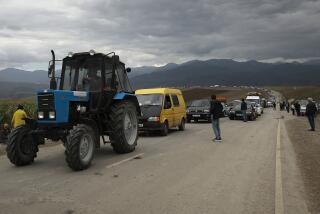A Desperate, Destitute Nation Deserts Itself
CHARENTSAVAN, Armenia — Masis Kocharian is a typical resident of this town, which is to say that he is tired, poor and yearning to be gone.
He is so desperate to get away--like half of the town before him--that given the chance he will offer you his two-room apartment in a workers dormitory and all the furnishings. All he asks for in return is bus fare to Russia and a few dollars to get settled there--maybe $250 at most.
“And I promise,” he adds, “you will never see me again.”
To Armenian patriots, Kocharian is an all too common example of a national dream gone sour.
For centuries, Armenians were a people without a state, ruled over by Turks, Persians, Mongols and Russians. In World War I--their blackest hour--they were rounded up, starved, raped and murdered in a genocide that foreshadowed the worst crimes of the century.
Those who survived took sanctuary under Soviet rule or scattered across Europe, the Middle East and the Americas, keeping alive their 1,700-year-old Christian faith, their customs and their language with its unique alphabet invented by a monk in AD 404.
Then, in 1991, with the collapse of the Soviet Union, an unforeseen opportunity opened up. For the first time since the Middle Ages, the Armenian people had their own sovereign state, a homeland where they could return, prosper and build a secure future for their children.
Ten years later, however, the hopes remain unfulfilled. Instead of the Armenian diaspora flocking home to build their country, the opposite is occurring: Armenians are leaving at an alarming pace. Of the nearly 3.7 million living in the country at the time of independence, an estimated 1 million have left.
Standing in the square of this poverty-ridden factory town, where all nine plants have shut down, it’s easy to see why they go. Clothes are shabby. Cheeks are hollow. Belts are cinched tight. Desperation is written on almost every face. And almost every day, the buses leave for Russia and beyond, carrying a new cargo of emigrants.
Designed as a model industrial city 20 miles north of the capital, Yerevan, to serve the aims of the Soviet Union, Charentsavan lost its economic purpose when the Soviet Union ceased to exist.
Cut off both from raw materials and customers, its defense, tool, cement and machine-making factories collapsed. Armenia’s six-year war with its eastern neighbor, Azerbaijan, over the disputed enclave of Nagorno-Karabakh, and a consequent trade embargo with its western neighbor, Turkey, only worsened the suffering. The town began to wither.
Out of a population of 45,000, more than 20,000 people have left, says Charentsavan Mayor Rudolf Mnatsakian.
Of those still here, at most 2,200 have jobs. “It is a tragedy for our town and for Armenia,” he says. “We are trying to stop the emigration, but nature is stronger: If there is nothing to eat in a family, it is only logical to leave.”
Bus station manager Yuri Gasparian adds it up: “The math is simple. An average monthly salary is $6, while a kilo of bread costs 38 cents. So your salary is not even enough to buy you bread and water.”
Despite Foreign Aid, 80% Live in Poverty
Charentsavan is not unique in Armenia. Aside from the thin layer of development in the capital, the country is grindingly poor. Despite $1.4 billion in U.S. aid over the past decade, and the government’s attempts to promote commerce and investment, 80% of the country’s people live in poverty on less than $25 a month, says sociologist Gevorg Poghosyan.
The official unemployment rate is 17%, but a more accurate figure is 50%, he says. And even people who have jobs often don’t get paid.
Under the circumstances, economic emigration has hidden benefits for Armenia, Poghosyan points out. Those who leave find jobs abroad--mostly in Russia--and send money back to their dependents here. “It means less social and political tension, because those people are not all here demanding work,” he says.
But on the other side, “it is very bad, because we have lost our population. Armenia is being depopulated. Families are breaking up,” he says. “And those who are leaving are the ones who are the most economically active.”
The emigration is also reflected demographically. With so many men working abroad, Poghosyan says, there are now 57 women to every 43 men, an imbalance that hinders the creation of families.
Poghosyan, head of the Armenian Sociological Assn., says that three-fifths of the emigres go to Russia because it is nearby and because they have no language difficulties there. One-fifth go to Western Europe or the United States, and the others are dispersing around the world. (There are many more ethnic Armenians outside Armenia than inside it. Southern California, with 800,000, is considered the world’s second-largest Armenian center after Yerevan.)
“If you have the chance to leave Armenia, you must do it,” says Kocharian, the man desperate to sell his apartment. “And as soon as possible.”
Kocharian and his wife live on the fifth floor of the workers dormitory. He has not seen their children in the four years since he sent them to live with relatives in Russia. At the moment, he says, he cannot even afford a stamp to answer his son’s latest letter. Once a driver, Kocharian has not held a steady job in 10 years.
“Now I survive on buying things cheaply and then trying to sell them in a different village, with a very small markup,” he says. “But it gives me too little.”
If he makes it to Russia, he vows, he will be happy to dig the earth with a rusty spade or to clean toilets--anything to survive.
History Weighs Heavy on an Ancient Society
The principal of Charentsavan High School No. 5, Pap Shakhnazarian, says he has seen enrollment fall from 1,175 in 1986, when he started as a mathematics teacher, to 560. Forty students have left since September.
“If the exodus of Armenians is not stopped, there will be no one left in this country in a couple of years,” Shakhnazarian says. “It is strange, this feeling like a boarder in your own country. You know that . . . sooner or later, you too will have to leave.”
The other two newly independent ex-Soviet states next door, Georgia and Azerbaijan, have also seen their populations severely depleted, losing more than half a million people each, for similar reasons.
But the exodus is especially poignant for Armenia, whose people have paid a bitter price in the last century for the lack of a secure state.
Armenians are one of the oldest societies in recorded history. They were known 2,500 years ago to ancient Persia, mentioned by Greek historian Herodotus and described by the geographer Strabo before the birth of Christ. Contemporary Armenians regard themselves as the descendants of the sons of Noah, whose ark after the flood is supposed to have landed on Ararat, the snow-glazed mount that they consider their national emblem.
From any tall building in Yerevan today, one can easily see Ararat rising majestically nearly 17,000 feet, its green-gray slopes and rounded peak dominating the horizon. But it is difficult for Armenians to go there. Mt. Ararat now lies on the other side of a heavily fortified frontier with Turkey.
The sight of it is a daily reminder to Armenians of how they were cut off from the western sphere of their traditional land in what they consider the first example of genocide in the 20th century.
“Every morning I look at it, and every morning I remember what happened to my family,” says Prime Minister Andranik Markaryan, whose grandparents lived in what was then called Turkish Armenia.
Historians differ on how many people died at the hands of Turkish nationalists in 1915 and 1916. Outside Turkey, estimates up to 1.5 million are generally accepted. But Turkey itself denies that there was ever an organized plan to exterminate Armenians en masse.
To the Armenians, however, the results speak for themselves, says Lavrenty Barsekian, director of the Armenian Genocide Museum and Memorial, a Soviet-built gray granite needle rising 144 feet above a hill overlooking Yerevan.
Barsekian notes that today’s Armenia is only a remnant, the smaller portion of Armenian lands that fortunately were under Russian rule at the time of the genocide. He credits Armenians abroad, the descendants of those who fled or were deported, with keeping alive the memory of those who were killed.
“The world must remember these acts, so that a genocide will never be repeated in the 21st century,” he says.
Outside Yerevan, in the peaceful, tree-lined precincts of Echmiadzin, the home of His Holiness Karekin II, the Supreme Patriarch and Catholicos of All Armenians, the tragedies of the genocide and the nation’s present economic crisis intermingle in the minds of clerics.
Sitting outside the main cathedral, where a petrified relic of Noah’s Ark is said to be preserved, a newly minted priest, 24-year-old Father Ignatius, expresses his feelings.
“I can only say with confidence that the church hopes for a better future,” he says. “Now there are no obstacles. For our nation, now is the time that the economic revival and the spiritual revival can begin.”
*
Alexei V. Kuznetsov of The Times’ Moscow Bureau contributed to this report.
More to Read
Sign up for Essential California
The most important California stories and recommendations in your inbox every morning.
You may occasionally receive promotional content from the Los Angeles Times.









